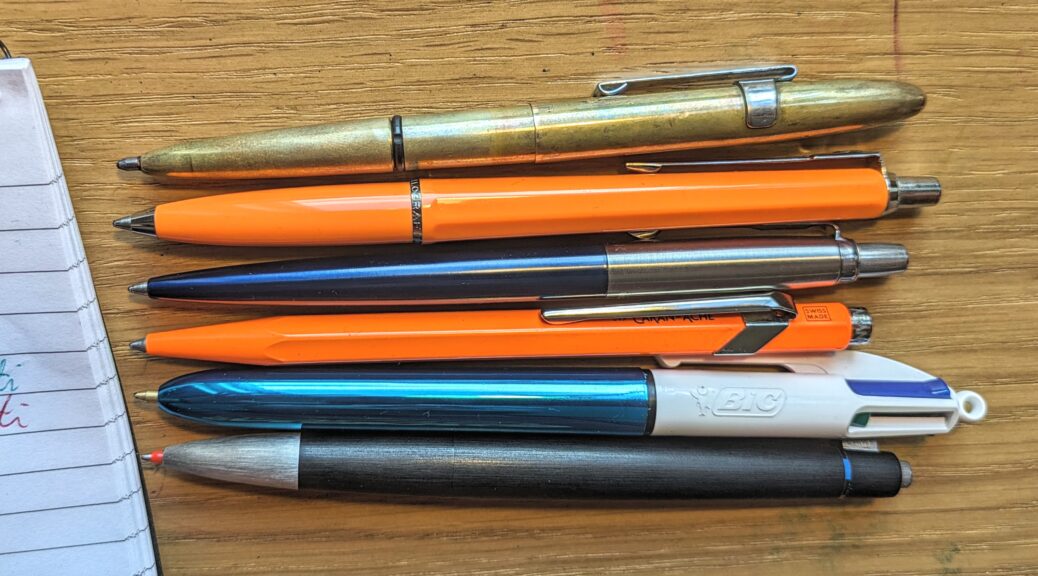
Nibby Sunday – Ballpoint pens I actually enjoy using
Us fountain pen enthusiasts have a small tendency to look down on ballpoint pens, but personally, I’ve found that both pen types have their uses. The fountain pen isn’t always the best tool, and in some situations the ballpoint pen is just better. In any case, there’s no reason to pit the two against each other. On the contrary, they actually complement each other quite well.
When the ballpoint pen came on the market after the war, it was quickly able to replace the fountain pen almost completely. The ballpoint was easier to use, and more practical. You didn’t have to fill it with ink regularly, and a refill lasted for months, even with a lot of writing. You avoided all the mess of having to dip the nib into an ink bottle to fill the pen, and not least the annoyance of picking up a fountain pen to write, only to discover that it was out of ink. There were also fewer incidents with leaks and the like with ballpoint pens. A ballpoint pen could, in general, take more abuse than the fountain pen, and was less vulnerable to damage if, for example, you dropped it on the floor. The ballpoint pens could be produced much more cheaply, and eventually also became a lot cheaper to buy than a fountain pen, which made it more accessible to people.
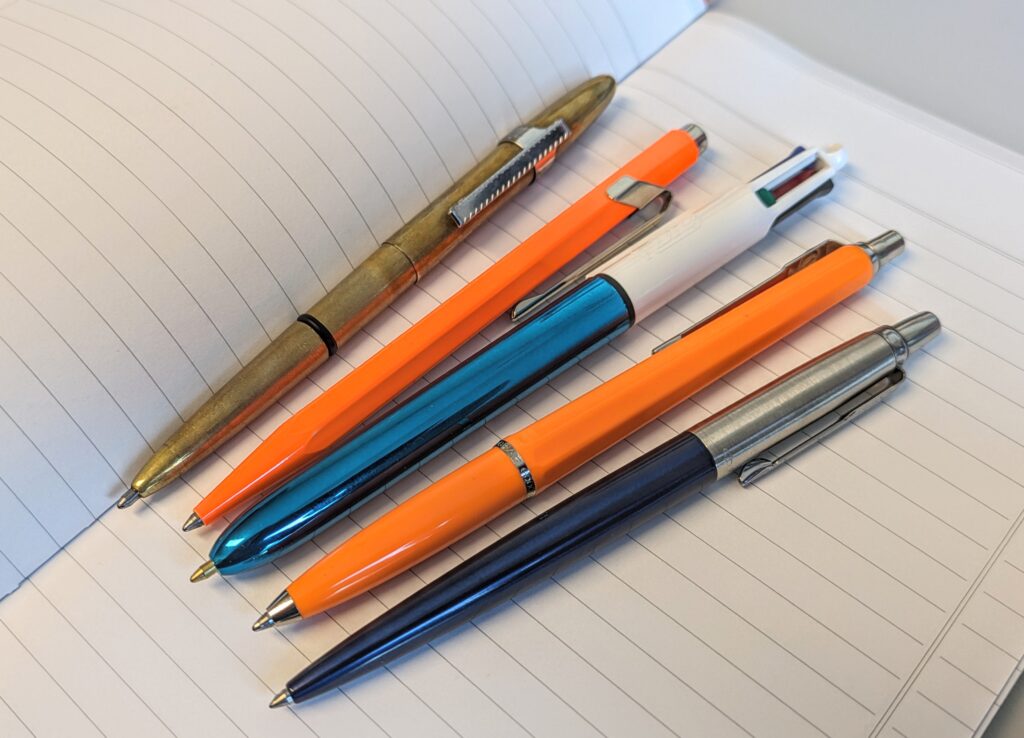
The fountain pen manufacturers were scratching their heads, trying to find new ways of doing things so that the fountain pens would be more practical, to meet this new competition. After a few years, they came up with different solutions for ink cartridges in fountain pens, which made them easier to fill without spillage. They also started designing fountain pens with hooded nibs, such as the Parker 51 or the early editions of the Aurora 88. With the nib partly inside the grip section, these pens looked more like the modern, streamlined ballpoint pens. But it was to no avail. It didn’t take more than 10-15 years after the first ballpoint pens were launched, until fountain pens were reduced to almost exclusively school pens. Few people bought fountain pens anymore,
In recent times, fountain pens have made a comeback, and are still growing in popularity. This might mostly be a reaction to all the new digital solutions in our society, and a desire to have some analogue activities, to get some time off from everything that happens in front of a screen and at a keyboard.
However, the ballpoint pens have been popular throughout, since they first appeared in the late 40s. They are still among the most popular types of pens, but our use of pens has changed. It’s not very often that people need to write long texts by hand anymore. If you want to write long-form, you would probably prefer to use a computer.

The fountain pen’s biggest advantage over the ballpoint pen is precisely that it’s comfortable to use when writing at length, an activity that few people do by hand anymore. For short and quick notes, the ballpoint pen is just as good, and in many cases actually preferable, because it’s easier to use, can write on any paper, the ink dries quickly, and it’s cheap (or oftentimes completely free).
Personally, I make sure that I always have a ballpoint pen with me wherever I go, so that I always have a practical writing tool at hand. But if I’m going to write a lot, I’d rather not use a ballpoint pen, no matter how good or practical it may be. For that purpose, the fountain pen is infinitely better. With a good fountain pen, I can write for hours without tiring my arm. Writing cramp doesn’t happen with fountain pens, at least I have never experienced it, as you can write completely relaxed with these pens. It also makes the writing look nicer, because you don’t have to use any energy to press the tip against the paper, as you have to with a ballpoint pen.
For longer texts, such as diary writing, letters, novel drafts, poetry writing, drafts for blog posts, brainstorming and much more, I would rather recommend a good fountain pen.
For short and quick notes, however, there’s not much that can compare with a good ballpoint pen. The ballpoint is also the way to go in the rare cases where you have to write on copy paper or carbon paper. That’s fortunately not very common any more, although if you’re a student, and have to do a written exam by hand, you might be asked to write on some kind of duplicating paper.
Anyway: here are six ballpoint pens that I personally really like:
Fisher Bullet
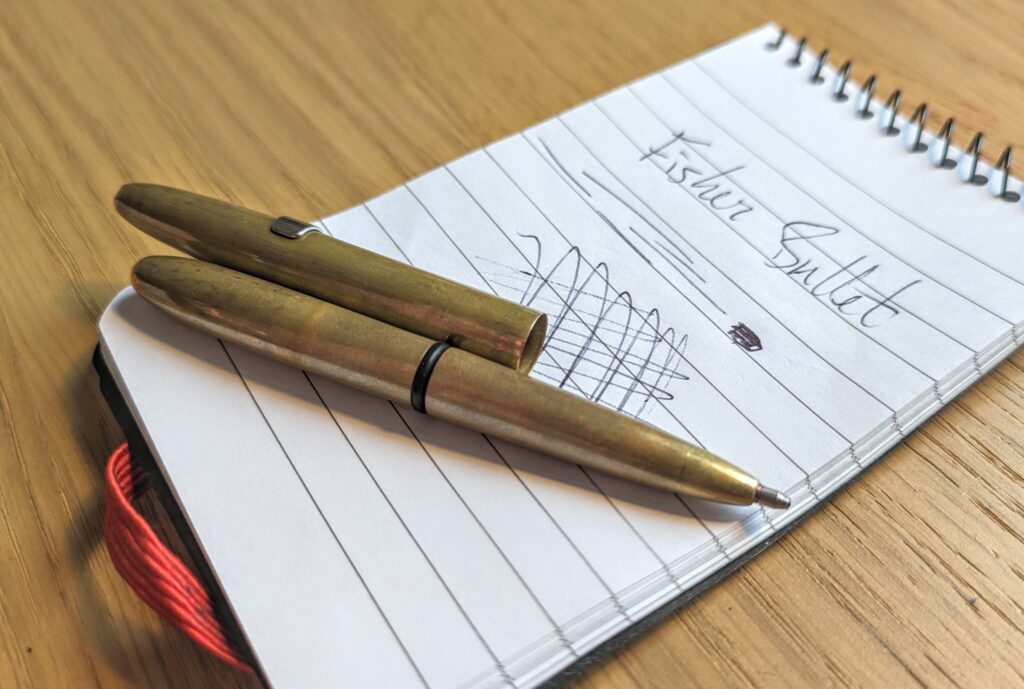
This is a must for those who need a pen they can keep in their pocket. It’s made of metal and can take a beating. Astronaut pen refills by Fisher are also among the very best ballpoint pen refills you can buy. They are pressurized so that they write upside down. This means that there should also be no problem with the ink flow at pressure and temperature differences, if you are sitting on a plane, climbing a mountain, or you somehow find yourself on the International Space Station. The ink is also waterproof. I myself never leave home without this in my pocket, and I use it daily.
Ballograf Epoca P
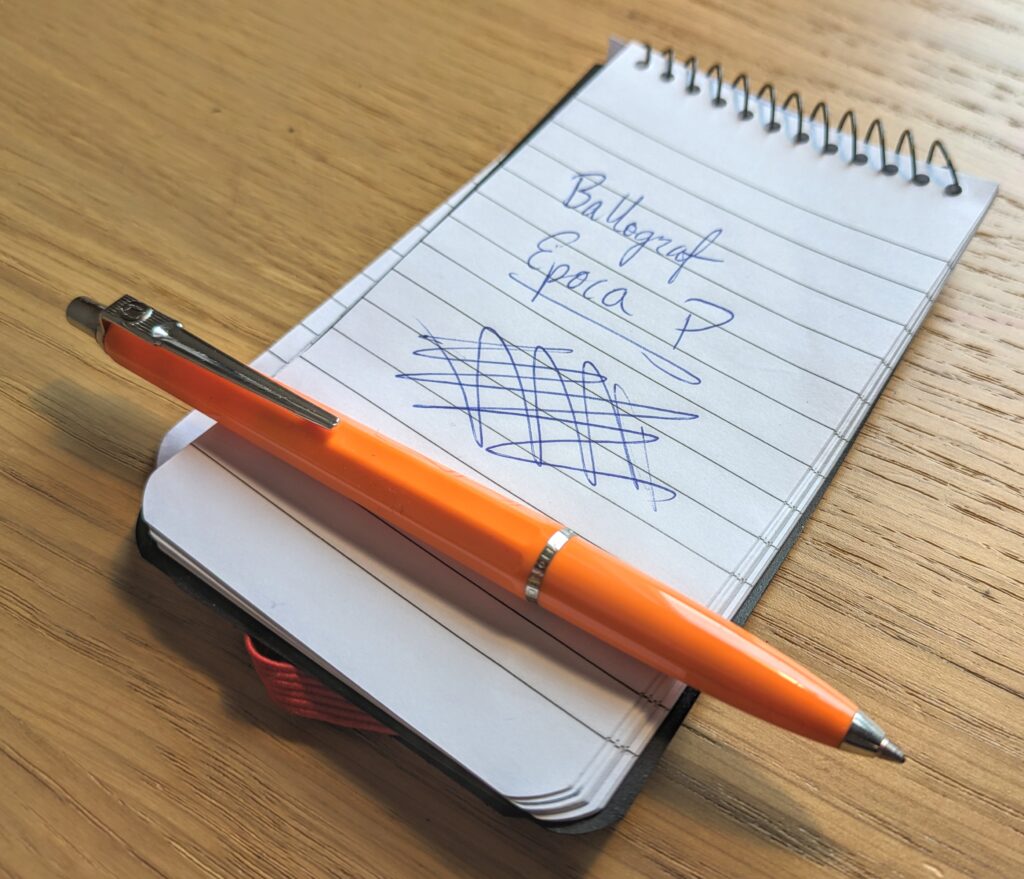
This Swedish pen has the best click mechanism out there, if you ask me. It feels safe and reliable, and the sound of it is the very definition of a “click”. Anyone who claim that the sound of the clicker doesn’t matter are definitely wrong. And the sound of this one is just beautiful. The best part is that the Ballograf clicker actually has a lifetime guarantee!
Epoca has been on the market since 1961, and is a true classic. As a Norwegian, I also think it’s great that we have a Scandinavian pen brand that is in the very top of their field, and still doing well. As I wrote about in this article (in Norwegian), Ballograf actually also had a Norwegian factory in the fifties.
While several of the other pens in this list are made of metal, the Ballograf Epoca P is made of plastic. That makes it a bit warmer and more comfortable to write with, at least that’s how I feel about it, in addition to the fact that it’s lighter in weight. The Ballograph refill also writes quite comfortably and effortlessly compared to many other ballpoint pens.
Parker Jotter
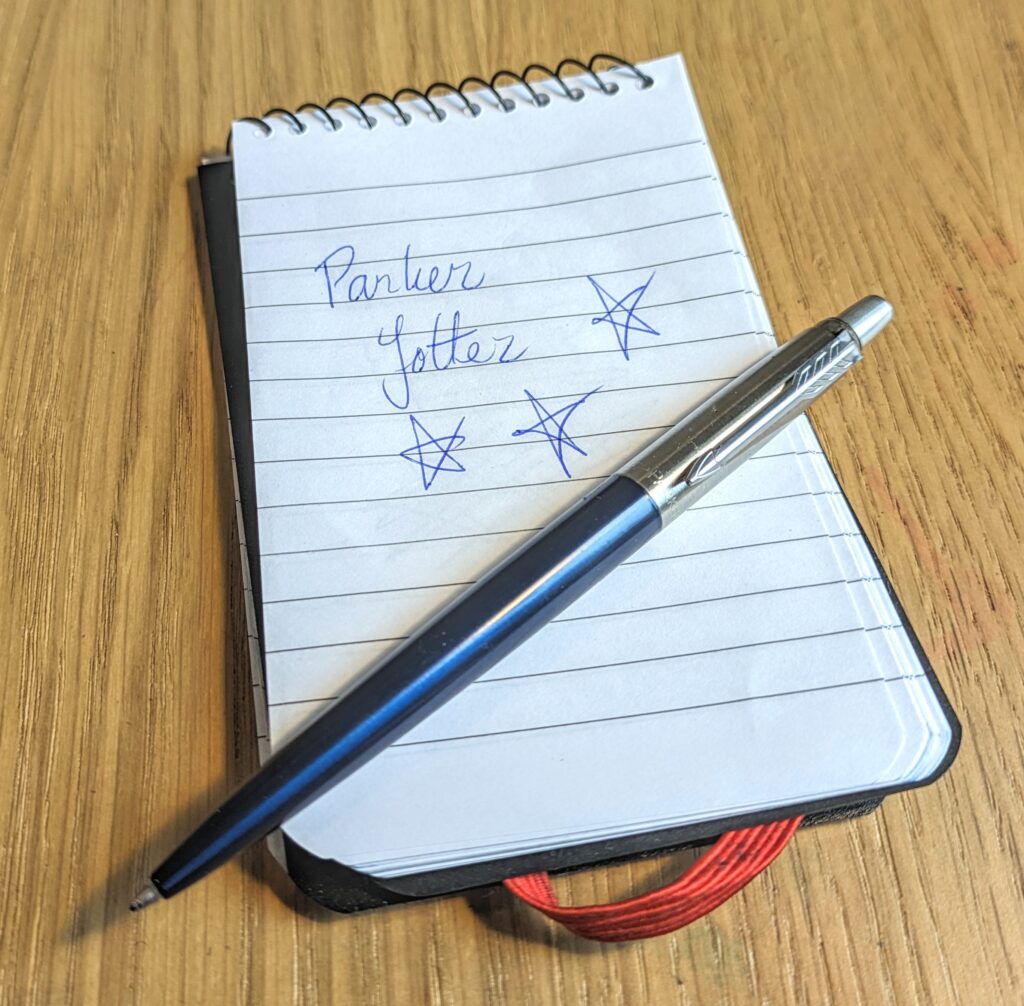
Parker Jotter was first launched in 1954, after a nine-year research and development process. It was Parker’s first ballpoint pen, and they wanted to be absolutely sure they had a good product, even if it meant they didn’t join in on the ballpoint pen war of the late 1940s, where several big pen brands battled it out for a share of the ballpoint market. When the Jotter was launched, it was a revolution that in many ways revived ballpoint pens again, after several pens of poor quality had been thrown unto the shop shelves in haste during the fierce market competition in the post-war years.
The Parker Jotter is rock solid, and I’m almost tempted to say it’s one of the best Parker pens on the market today (even when you include their fountain pens). You can buy both ballpoint and gel refills that fit in this, and both variants write very well. The clicker is a little heavier than the Ballograf clicker, and gives a deeper sound, but it also has a little more slack, and some extra little noises, which makes me like the Ballograf better. The Jotter is made of metal, and is quite thin down towards the tip. It’s a little cold and hard for my taste, but when you mainly use a ballpoint pen for short notes it doesn’t really matter. I’m not sure if they are also available with plastic grip sections. There are quite a few variants on the market, so I won’t rule it out, although I haven’t found one.
Caran d’Ache 849
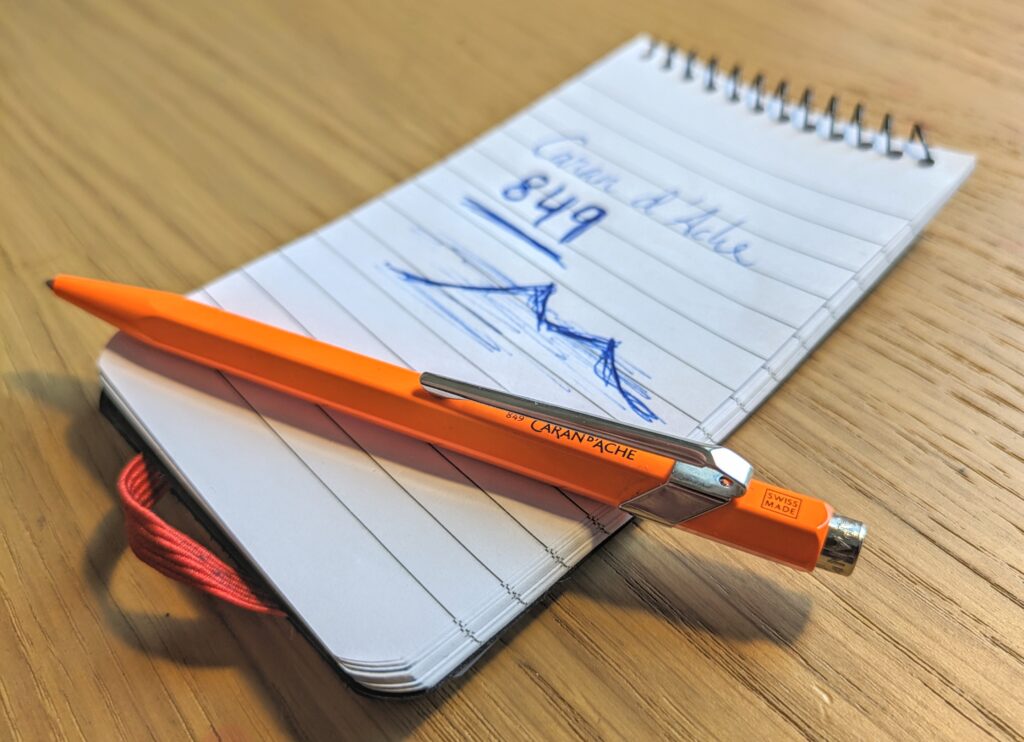
This one is a little more expensive than the Parker Jotter and Ballograf Epoca, but otherwise definitely comparable to them. Unfortunately, it doesn’t feel as well built, but makes up for it with the stylish, hexagonal design.
The clicker on this one doesn’t really deserve to be called a clicker. I would rather just call it a simple push button. It doesn’t make a click sound at all, but more of a silent high-frequency creak. The push button mechanism also doesn’t seem to be as reliable as Ballograf’s and Parker’s clickers. Sometimes it gets stuck a bit, and you have to press it an extra time or two to get the tip in the right position.
Apart from that, I think the pen is absolutely superb, and Caran d’Ache’s ballpoint pen refill is probably as good as the other pens on this list. The pen is made of metal, but does not feel as cold as the Parker Jotter. On the contrary, it’s actually really comfortable to write with. The fact that it’s hexagonal instead of round also means that you get a slightly better grip on it.
Bic 4 Colors multipen
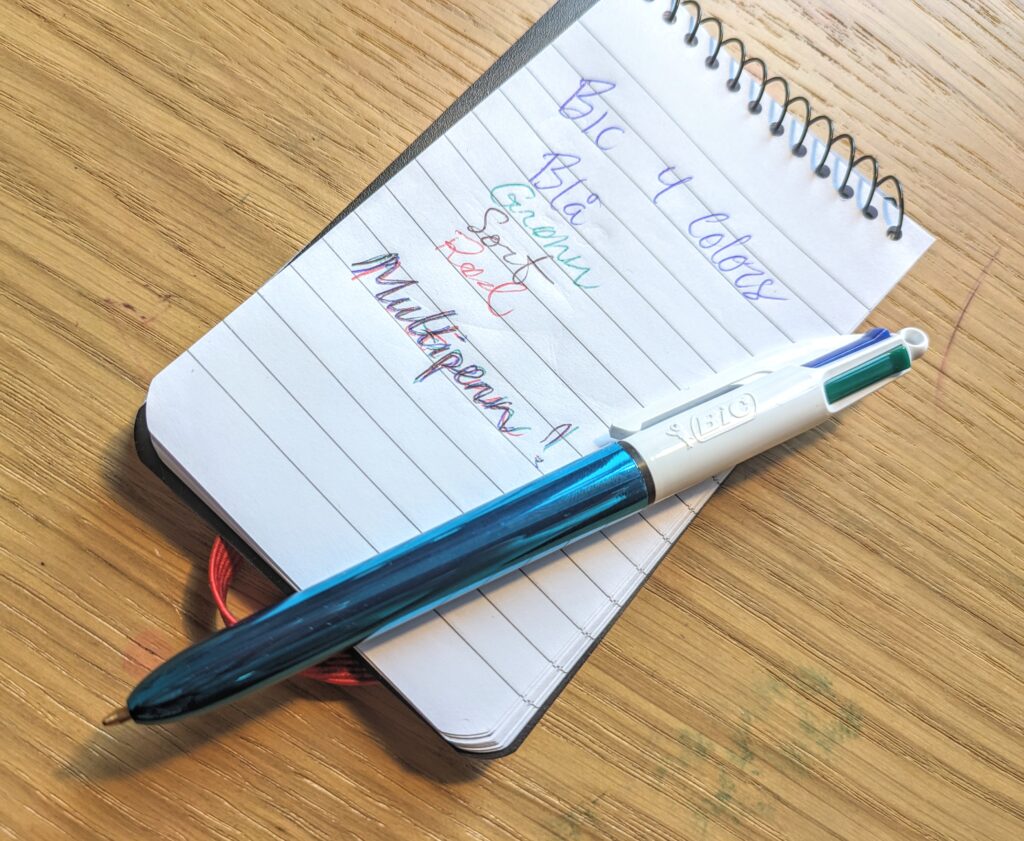
The classic multipen! A multipen is incredibly practical. Here you get four colors in one pen, and the mechanism for clicking the various tips in and out of the pen is highly fidget-worthy. The pen also has a small ring you can put a thread through, so that you can wear it around your neck, if you prefer.
This pen is made of plastic, and doesn’t feel as exclusive as the Ballograf, even though they cost about the same. The plastic looks and feels a bit cheap, and it appears to be the least sturdy pen on this list. At the same time, it’s probably the one out of these pens that writes most smoothly and comfortably. The refills that Bic has used in this pen write almost as effortlessly as a rollerball or gel pen. The pen itself is also larger and thicker than the other pens on the list, which means that it fits a little better in my hand. The result is a surprisingly comfortable writing tool for a ballpoint pen.
Lamy 2000 multipen
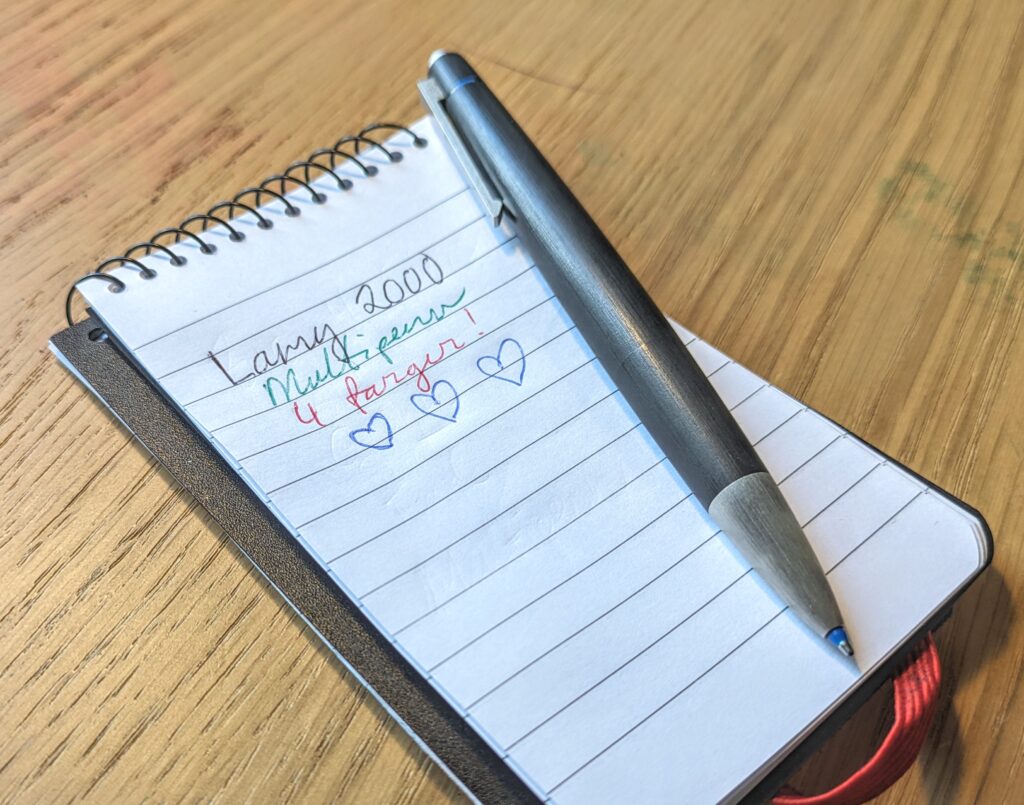
This is the multipen for those who want something a little more stylish and proper, or if you just want a ballpoint pen that matches your Lamy 2000 fountain pen. It’s a few price points above the other pens on this list, but I include it because I think it’s a fantastic pen.
It feels as good in the hand as a Lamy 2000 fountain pen, and is made of the same Makrolon material. Like the Bic pen, it has four refills but only one push button. Which color you want is controlled by gravity, and which angle you hold the pen when you click the button. Right under the button there’s a small band showing the four colours, and the side of the pen you hold upwards determines the color. It’s a very clever mechanism, and feels almost like magic, when you can change the color, although only pushing one button.
The pen has a great design, fits well in the hand, and has a very cool mechanism, but Lamy’s refills do not write as well as the other pens on this list. There is more resistance, and you have to press it a little harder against the paper to get a good line. And like the Caran d’Ache pen, the sound in the button is more of a plaintive creak than a click, as if the pen is saying “ooooohhh… I have to wriiite agaaaain…?” .